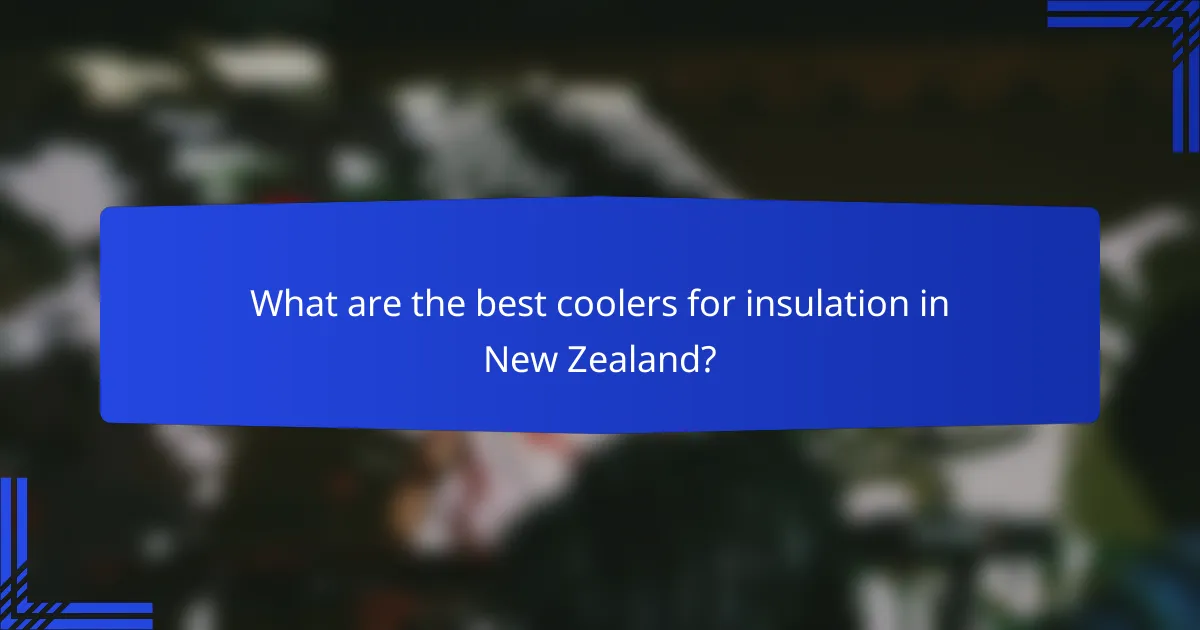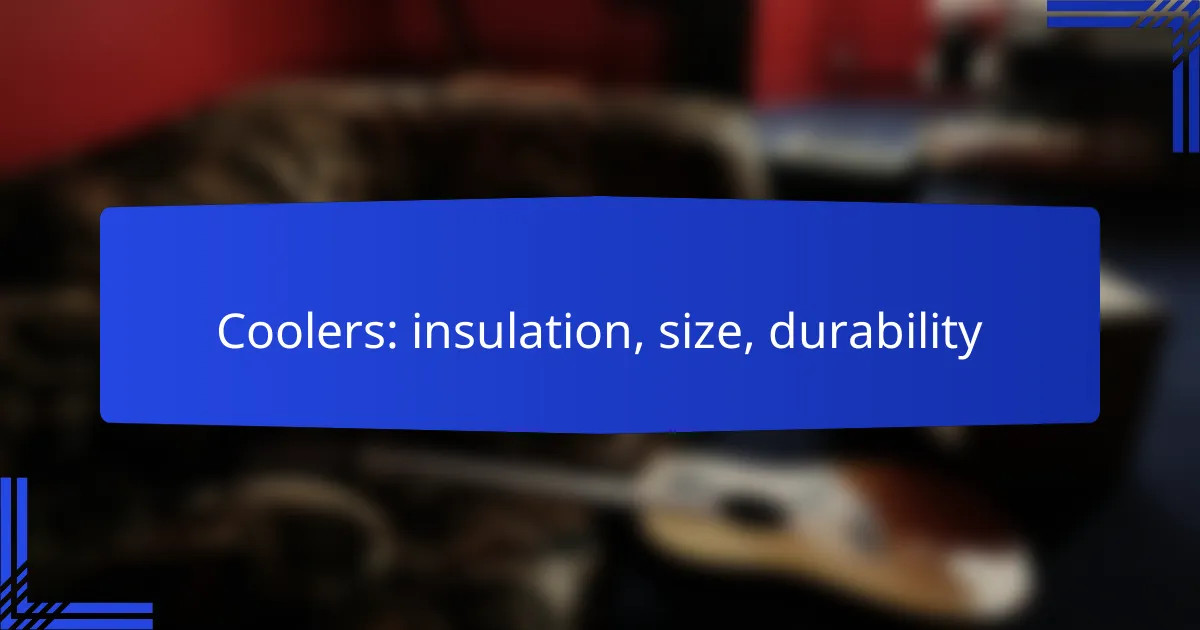When choosing a cooler, insulation, size, and durability are key factors to consider for optimal performance. Effective insulation ensures that your cooler maintains low temperatures for extended periods, making it perfect for outdoor adventures. Additionally, selecting the right size based on your needs and ensuring the cooler is built with high-quality materials will enhance its longevity and portability.

What are the best coolers for insulation in New Zealand?
The best coolers for insulation in New Zealand are those that effectively maintain low temperatures for extended periods, making them ideal for outdoor activities. Look for coolers with thick walls, quality seals, and durable materials to ensure optimal performance in various climates.
YETI Tundra 45
The YETI Tundra 45 is renowned for its exceptional insulation capabilities, featuring up to 7.6 cm of polyurethane foam in the walls. This cooler is designed to keep ice for several days, making it perfect for camping trips or beach outings.
Its rotomolded construction ensures durability, while the non-slip feet provide stability on uneven surfaces. The Tundra 45 also includes a heavy-duty lid that doubles as a seat, adding to its versatility.
Igloo Yukon Cold Locker
The Igloo Yukon Cold Locker offers impressive insulation with thick foam walls and a secure lid that locks in cold air. This cooler is designed to hold ice for up to five days, depending on external temperatures.
Its rugged construction makes it suitable for rough outdoor conditions, and the integrated handles allow for easy transport. Additionally, the Yukon Cold Locker features a built-in bottle opener, enhancing its practicality for outdoor gatherings.
Pelican Elite 45
The Pelican Elite 45 is built for serious outdoor enthusiasts, boasting up to 5.1 cm of insulation for superior ice retention. This cooler can keep contents cold for several days, even in warmer weather.
Constructed with a durable exterior, it is both impact-resistant and bear-proof, making it ideal for camping in the wild. The cooler also includes a lifetime warranty, reflecting its high-quality design and reliability.

How to choose the right cooler size?
Selecting the right cooler size involves considering the number of people you’ll be serving, the duration of your outing, and how portable you need the cooler to be. A cooler that is too small may not hold enough supplies, while one that is too large can be cumbersome to transport.
Consider group size
The size of your group is a primary factor in choosing a cooler. For small gatherings of 2-4 people, a cooler with a capacity of around 20-30 quarts is often sufficient. Larger groups, such as 6-10 people, typically require coolers in the 40-70 quart range to accommodate food and beverages comfortably.
As a rule of thumb, plan for about 1 quart of cooler space per person for a day trip. This ensures everyone has enough drinks and snacks without overcrowding the cooler.
Evaluate duration of use
The length of your outing significantly influences cooler size. For short trips lasting a few hours, a smaller cooler may suffice. However, for day-long events or camping trips, consider a larger cooler that can hold ice for extended periods.
Coolers designed for longer durations often feature better insulation and can maintain cold temperatures for 2-5 days, depending on the model. Assess your needs based on how long you plan to be away from refrigeration.
Assess portability needs
Portability is crucial when selecting a cooler, especially if you’ll be carrying it over long distances. Lightweight, smaller coolers are easier to transport but may sacrifice capacity. Conversely, larger coolers can be heavy and cumbersome, particularly when filled.
Look for features like wheels, sturdy handles, and lightweight materials if you need to move the cooler frequently. A cooler that balances size and weight will enhance your outdoor experience without becoming a burden.

What factors affect cooler durability?
Cooler durability is influenced by material quality, construction techniques, and brand reputation. Each of these factors plays a crucial role in determining how well a cooler can withstand wear and tear over time.
Material quality
The materials used in cooler construction significantly impact its durability. High-density polyethylene (HDPE) and rotomolded plastics are often preferred for their resistance to cracking and UV damage. Metal coolers, while heavier, can offer superior durability and longevity.
When selecting a cooler, look for those made with thick walls and reinforced corners, as these features enhance structural integrity. Additionally, consider insulation materials; closed-cell foam provides better thermal performance and can contribute to overall durability.
Construction techniques
How a cooler is constructed affects its ability to endure harsh conditions. Welded seams and double-walled designs typically offer better protection against leaks and impacts. Coolers that utilize injection molding can provide a more consistent and durable product compared to those made with less precise methods.
Pay attention to the cooler’s design features, such as handles and latches. Heavy-duty, corrosion-resistant hardware can prevent wear over time, ensuring that the cooler remains functional and intact during use.
Brand reputation
Brand reputation often reflects the quality and durability of coolers. Established brands with positive reviews are more likely to produce reliable products that stand the test of time. Researching customer feedback can provide insights into long-term performance and durability.
Consider brands that offer warranties or guarantees, as these can indicate confidence in their product’s durability. A good warranty can also provide peace of mind, knowing that the manufacturer stands behind their cooler for an extended period.

What are the top brands for durable coolers?
The top brands for durable coolers include YETI, Igloo, and Pelican, each known for their robust construction and effective insulation. These brands offer a range of products suited for various outdoor activities, ensuring that your food and beverages stay cold for extended periods.
YETI
YETI is renowned for its high-performance coolers, designed to withstand rugged conditions while providing exceptional insulation. Their products often feature rotomolded construction, which enhances durability and resistance to impacts.
When choosing a YETI cooler, consider models like the Tundra series, which come in various sizes, making them suitable for everything from day trips to extended camping adventures. Their coolers typically maintain ice retention for several days, making them a favorite among outdoor enthusiasts.
Igloo
Igloo has a long-standing reputation for producing reliable and affordable coolers that cater to a wide audience. Their products range from lightweight, portable options to larger, heavy-duty models designed for serious outdoor use.
Popular choices include the Igloo Marine series, which offers UV protection and corrosion resistance, ideal for boating and fishing trips. Igloo coolers generally provide solid insulation at a more accessible price point, making them a practical choice for casual users.
Pelican
Pelican coolers are built with a focus on extreme durability and performance, often featuring heavy-duty materials and advanced insulation technology. They are designed to withstand harsh environments, making them suitable for both recreational and professional use.
Consider the Pelican Elite series for top-tier performance, as these coolers are known for their ice retention capabilities and robust construction. While they may come at a higher price, their longevity and effectiveness can justify the investment for serious outdoor adventurers.

How does insulation type impact cooler performance?
The type of insulation significantly affects a cooler’s ability to maintain temperature. Different insulation materials offer varying levels of thermal resistance, impacting how long the cooler can keep items cold or hot.
Foam insulation
Foam insulation is commonly used in coolers due to its lightweight and cost-effective properties. It typically consists of expanded polystyrene or polyurethane, which provides decent thermal resistance, keeping contents cold for several hours to a couple of days, depending on external conditions.
When choosing a cooler with foam insulation, consider the thickness of the foam, as thicker insulation generally offers better performance. However, be aware that while foam is effective, it may not provide the same level of durability as other materials, making it more susceptible to damage over time.
Vacuum insulation
Vacuum insulation offers superior thermal performance by creating a space devoid of air between two walls, significantly reducing heat transfer. This type of insulation can keep contents cold for several days, making it ideal for extended trips or outdoor activities.
While vacuum-insulated coolers tend to be more expensive, they are also more durable and resistant to impacts. When selecting a vacuum-insulated cooler, check for features like double-walled construction and robust materials to ensure longevity and performance in various conditions.
